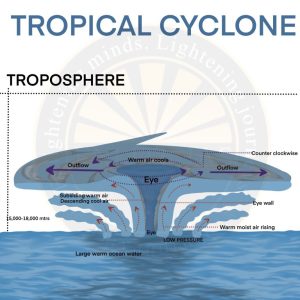Why in the news?
- Super Typhoon Ragasa hit Hong Kong with fierce winds and pounding rain, and headed into southern China.
Super Cyclone
- Definition: Super cyclones are extremely intense tropical cyclones that form over the ocean and can cause devastating damage when they make landfall. These storms are characterized by their exceptionally strong winds and heavy rainfall.
- Features
- Intense Winds: Super cyclones can produce sustained wind speeds of over 220 km/h (137 mph), capable of causing widespread destruction.
- Heavy Rainfall: These storms often bring torrential rainfall, leading to flooding, landslides, and erosion.
- Storm Surge: Super cyclones can generate massive storm surges, causing coastal flooding and inundation.
- Condition For Formation
- Warm Sea Surface Temperature (≥ 27°C).
- High Ocean Heat Content (depth of warm water > 60 m).
- Low Vertical Wind Shear (winds not disrupting vertically).
- High Relative Humidity in mid-troposphere.
- Coriolis Force (sufficient distance from equator, usually > 5° latitude).
- Example: Odisha Super Cyclone (1999)
- Landfall: Odisha coast (Paradeep).
- Wind speed: ~260–270 km/h.
- Casualties: ~10,000 deaths.
- Led to establishment of Odisha State Disaster Management Authority (OSDMA).
- Disaster Management
- Institutions: NDMA, IMD, INCOIS.
- Tools: Satellites (INSAT, SCATSAT-1), Doppler Weather Radars.
- Preparedness: Cyclone shelters, evacuation drills, Odisha model.
- Mitigation: Mangrove plantation, coastal zone regulations, resilient housing.

